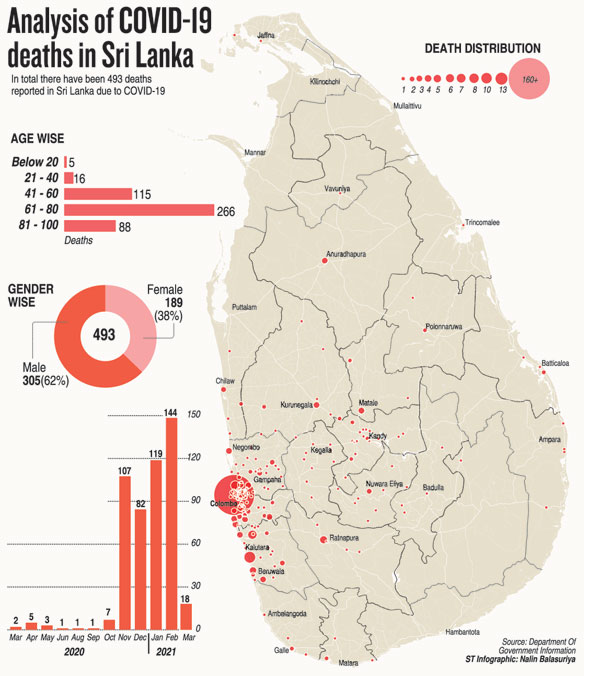News
Counting the COVID-19 dead
Sixty-two percent of reported COVID-19 fatalities in Sri Lanka were among men while a significant number of deaths–at least 16 percent–occurred at home, according to information released by the Government since March last year.
Women made up 38 percent of fatalities while nearly 39 percent of the deceased had some form of heart ailment (heart attack/failure and heart disease) listed as a reason for death along with COVID-19 infection.
In 15 percent of victims, cause of death included kidney issues; in 13 percent it included high blood pressure; and in 13 percent, diabetes. Liver complications were a factor but to a lesser degree.
The vast majority of deaths were listed as Covid pneumonia (217 cases or 44 percent) while 19 percent suffered from blood poisoning or sepsis.
The Global Sepsis Alliance has said that the virus can cause sepsis, which is the body’s overwhelming and life-threatening response to an infection that can lead to organ damage and death. The most common cause is pneumonia in which the air sacs fill with pus, making it difficult to breathe.
Fifty-four percent of COVID-19 fatalities were in the age group of 61 to 80 while 23 percent were in the 41 to 60 age group. The third largest category was 81-100, at 17 percent. Eleven of the deceased were in their 90s with the oldest in that age group—a man from Kotte who died on December 6—being listed as 98. There were 85 octogenarians and 143 people in their seventies while 121 were in their sixties.
The youngest victim was just 20 days old, a baby boy named Shaykh who died at Lady Ridgeway Hospital on December 9 of blood poisoning, multi-organ dysfunction and COVID pneumonia. An 18-month-old baby boy died at the same hospital on February 1 of COVID pneumonia. The third youngest was a 15-year-old boy who died at the Apeksha Hospital in Maharagama on December 22 of Covid pneumonia, blood poisoning and acute leukemia.
The Sunday Times tabulated the data starting on March 28, 2020, when the first COVID death was recorded of a 60-year-old man from Marawila who was the second Sri Lankan to have contracted the virus. The statistics collected were three short of the national total (as at Friday) of 493. Calculations were, therefore, made on the data pertaining to 490 deaths.
Such information is now systematically released by the Department of Government Information (DGI) on a daily basis. Some of the fatalities could go back several days but we ranged them according to date-of-death.

The case studies of three COVID-19 fatalities–selected at random and reported on by the Sunday Times last month–are still not in the national data, it was found. They pertain to a 75-year-old man from Kadawatha who died on January 12; a 68-year-old woman from Mt Lavinia who died on January 15; and a 91-year-old woman who died at a home for the aged in Pandura on February 1.
The national data also does not list the oldest Sri Lankan who succumbed to the virus at the age of 102. The woman died at her residence in Galle in early February.
The DGI started including the precise date-of-death from the third week of November. Till then, they were often reported according to the day on which the information was released. Since November 20, at least
Since November 20, last year, deaths took place every day till Friday, except on December 8, 23 and 27 and January 5. There was at least one fatality daily while the highest number reported in a day was 11, on November 21 and February 5.
Colombo recorded the highest number of deaths, with a total of 151 deaths (excluding prison inmates who died in Colombo jails). The worst affected were Colombo 15 with 32 fatalities; Colombo 10 with 29 fatalities; Colombo 13 with 19 fatalities; Colombo 12 with 15 fatalities; and Colombo 14 and 8 with 12 fatalities each.
There were 10 deaths from Kalutara (North and South); none from Wellampitiya; eight each from Wattala and Kolonnawa; and six from Nugegoda.
The Homagama Base Hospital handled the heaviest caseload of most serious patients, according to the statistics, recording 92 deaths—nearly 19 percent—of a total of 490. It is a dedicated COVID-19 treatment centre and official information indicates that patients were routinely transferred there when they showed complications.
The National Hospital of Sri Lanka also saw 55 deaths—or 11 percent—while the Mulleriyawa Base Hospital, another dedicated centre, recorded 40, or eight percent.


